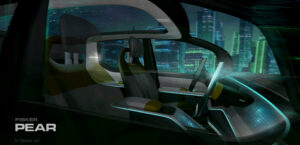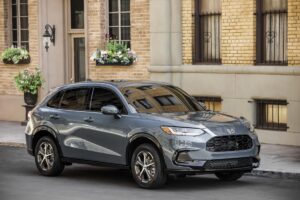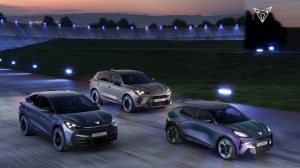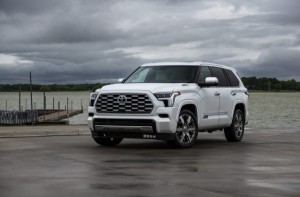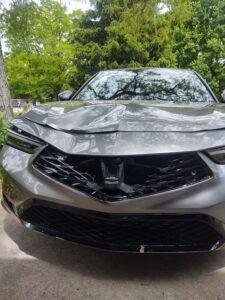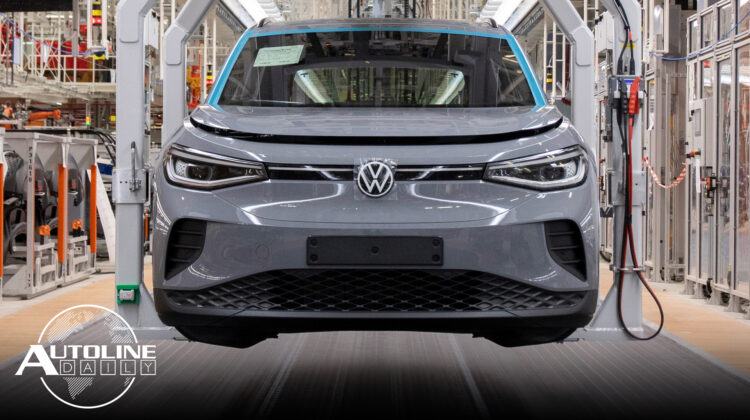
Listen to “AD #3341 – VW Scraps All Previous EV Work; 1.5 Million Car Crashes A Year with Deer; Toyota To Triple Sequoia Sales” on Spreaker.
Follow us on social media:
Runtime: 11:18
0:07 UAW Boosts Strike Pay
0:51 Automakers Who Back California Emissions
1:35 Fisker Teases More of the PEAR
3:11 Honda Redesigns the HR-V
4:02 Cupra Going Electric/Electrified
5:13 VW To Scrap All Previous EV Work
7:19 Toyota To Triple Sequoia Sales
9:33 1.5 Million Car Crashes A Year with Deer
Visit our sponsors to thank them for their support of Autoline Daily: Bridgestone, Intrepid Control Systems, MEDC and Schaeffler.
This is Autoline Daily, the show dedicated to enthusiasts of the global automotive industry.
UAW BOOSTS STRIKE PAY
The United Auto Workers union is getting ready for next year’s contract negotiations with GM, Ford and Stellantis. It’s already preparing for a potential strike. Yesterday, the union raised the strike pay to $400 per week, up from $275. That’s how much each worker will get if they go on strike, which isn’t much. That works out to about $10 a hour. The union has $826 million in its strike fund. It also removed a rule that prevented members from collecting strike pay if they’re receiving unemployment benefits. So striking members can collect unemployment on top of their strike pay.
AUTOMAKERS WHO BACK CALIFORNIA EMISSIONS
Five automakers are putting their muscle behind California’s effort to reinstate its ability to set its own vehicle emission standards. Ford, Volkswagen, Honda, Volvo and BMW filed a motion in court to back the EPA’s decision to restore California’s emissions authority which was revoked during the Trump Administration. In March, the EPA reversed the Trump decision but last month a group of 17 states filed a challenge to that ruling. But 17 other states have adopted California’s tailpipe emission standards and 15 of them are on board for its zero-emission vehicle requirements.
FISKER TEASES MORE OF THE PEAR
Fisker dropped more details about its PEAR electric crossover and released this teaser image of the interior. It doesn’t show much but the company says the interior “will offer a new level of storage for its segment” and it’s been designed to give a “commanding view when driving.” The company says it has 3,200 reservations for the model which has a starting price below $30,000. The PEAR is offered with two battery packs, with the larger one having 310-miles of range. The PEAR will be fully revealed in the second half of 2023 and go into production at Foxconn’s plant in Lordstown, Ohio in 2024.
HONDA REDESIGNS THE HR-V
Honda is coming out with an all-new version of the HR-V, the compact crossover in its lineup, which is built on the same platform as the Civic. It gets new styling, a longer wheelbase, and a bigger 2-liter engine that generates 158 horsepower and 138-pound feet of torque. That’s up 17 horsepower and 11-foot pounds. Base price for a front wheel drive version in the US is just under $25,000, while all-wheel drive is about $26,400. A fully loaded version just tops thirty grand. The front drive version is rated at 28 miles to the gallon, while all-wheel drive comes in at 27. You’ll start seeing them on the street pretty soon. They’re being shipped to dealers as we speak.
CUPRA GOING ELECTRIC/ELECTRIFIED
Cupra, the high-performance brand of Spanish automaker SEAT, which is part of the VW Group, aims to sell 500,000 vehicles a year and it will introduce three new electrified vehicles by 2025. The first is the Terramar, a plug-in hybrid SUV, which will have 100 kilometers or 62 miles of electric range. ICE versions of the model will also be available and it will be produced at an Audi plant in Hungary. The next model is the Tavascan, which will launch in 2024. Cupra didn’t share many details about it but says it will retain design elements from the concept it showed in 2021. And lastly is the UrbanRebel, an all-electric small hatchback that’s built on VW’s MEB small platform. It features a 166-kW electric motor, has a 0 to 100 km/h time of 6.9 seconds and a range of 440 kilometers or about 273 miles of range. The UrbanRebel launches in 2025 and will be built in Spain.
VW TO SCRAP ALL PREVIOUS EV WORK
Despite all that work at Cupra, the Volkswagen Group is essentially going to throw out all the development work it’s already done on electric cars. Say goodbye to the MEB architecture used on VWs EVs as well as the PPE platform, or Premium Platform Electric, used by Audi and Porsche. Instead, say hello to the SSP, or Scalable Systems Platform. It’s a skateboard design that’s going to be used on every single EV from every single brand from the group, including VW, Porsche, Audi, Seat, Skoda, Lamborghini and Scout. Talk about scale. Over its lifetime, VW expects to build 40 million electric vehicles off this platform. It’s all part of VW’s Trinity program, which is supposed to help VW catch up to Tesla. Herbert Diess, CEO of the VW Group, says by co-locating engineers, and having them collaborate more, it will slash new product development time from 54 months down to 40 months. But those vehicles will be built around a new electronic architecture that’s coming out of VW’s CARIAD project. It’s designed to handle 200 million lines of code, which is twice what the current MEB platform can handle. This all sounds pretty exciting, except that the first cars to come out of this new PD process will not be out until 2025.
TOYOTA TO TRIPLE SEQUOIA SALES
It’s been a long time in coming but it’s finally here. Toyota finally got around to redesigning the Sequoia SUV which has not changed since it came out in 2008. The big news is that it gets the same hybrid powertrain that’s offered in the Tundra pickup truck. That includes a 3.4-liter twin-turbo V6 that kicks out 437 horsepower and 583-pound feet of torque, and is mated to a 10-speed automatic. Toyota says it will get similar fuel economy to the Tundra which gets 22 miles per gallon with rear drive and 20 with all-wheel drive.
The Sequoia is a full-size 3-row SUV that can tow 9,500 pounds, and comes standard with a locking rear differential and a multi-link rear suspension. It’s built on the same platform as the Tundra and the Land Cruiser. The rear drive version tips the scales at about 5,800 pounds, while the all-wheel drive version weighs just over 6,000.
There are 5 different trim levels starting with the SR5 which has a base price just under $59,800, and it tops out with the Capstone 4×4 at $79,800. A beefier looking off-road model, the TRD PRO, which is only available as a 4×4, costs about $78,400. All of them come with Toyota’s latest suite of safety equipment, what it calls Toyota Safety Sense 2.0.
Some other notable features include a 3rd row that slides forward or back for more legroom for passengers, or more cargo space in the back. And the cargo area can be configured in different ways to accommodate different types of cargo.
Last year Toyota only sold 8,000 Sequoias, compared to 48,000 Chevrolet Suburbans and 82,000 Ford Expeditions. But, Toyota thinks it can triple the sales of the Sequoia largely because it has such a large owner base that’s been waiting for the new one. We’ll find out if that’s the case later this fall, which is when it goes on sale.
1.5 MILLION CAR CRASHES A YEAR WITH DEER
Last Friday Acura dropped off the new Integra for me to test drive. I was supposed to have it for a week but it didn’t even last until the end of the day. That night, while I was doing about 70 miles an hour on the highway, a deer leaped out of the dark right in front of my car. I slammed on the brakes as fast as I could but it was too late. There was no avoiding it. The impact killed the deer instantly and it tore up the front end of the car pretty good. I was lucky it didn’t come through the windshield. And that got me interested in how many accidents there are between cars and deer. I was shocked at what I found. Stunned. Just in the state of Michigan, where I live, there are 51,000 crashes between cars and deer every year. 51,000! In fact, one out of every 5 car crashes in Michigan are with deer. On a national basis there are 1.5 million car crashes a year with deer. I had no idea it’s such a big problem. And I’m hoping that someone out there in the auto industry can figure out how to solve it. Maybe thermal cameras tied into automatic braking? I don’t know. But this is a serious problem that’s just begging for a solution.
And that wraps up today’s report. Thanks for watching Autoline Daily.
Thanks to our partner for embedding Autoline Daily on its website: WardsAuto.com
Seamus and Sean McElroy cover the latest news in the automotive industry for Autoline Daily.






